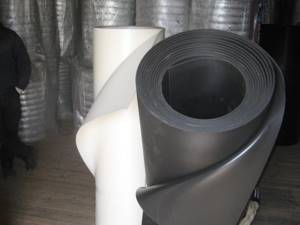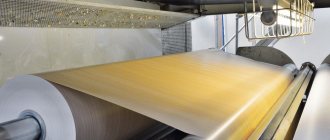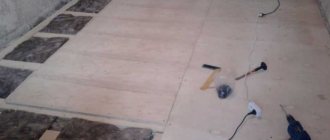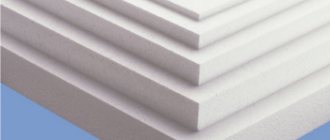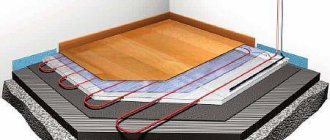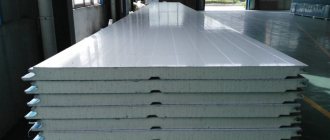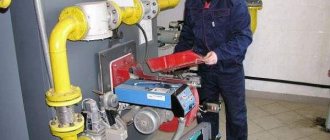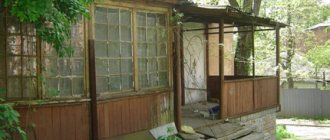In most apartments, it doesn’t make much sense to insulate the floor under the laminate. But if the flooring is installed in rooms on the ground floor or in a cottage, then additional thermal insulation should not be neglected. If the floors in such rooms are not insulated, then it will be almost impossible to walk in them barefoot or even in socks in winter.
The laminate finish itself is cold due to the top layer of resins. And if there is still cold from below in winter, it becomes completely “icy” to the touch. In such a situation, it is not recommended to leave a concrete screed or any other base underneath without insulation.
Why do you need insulation under laminate flooring?
Often, only a foam polyethylene backing is placed under the laminate. This is the minimum required by the manufacturers of the topcoat in question. However, in terms of insulation, such a bedding is frankly of little use. This rolled backing performs the function of sound insulation and eliminates the creaking of the lamellas when they rub against each other at the joints. For thermal insulation, in addition to it, other materials must be used.
Floor insulation helps to significantly save on heating costs
Insulation under the laminate is installed for the following reasons:
If the floor under the laminate itself is warm (there are heated living rooms on the floor below), then there is no need to insulate it. Such additional insulation will only be a waste of money and time on work.
But on the first floors in apartment buildings, as well as in rooms above unheated utility rooms or basements in cottages, thermal insulation for laminate flooring must be installed. Here it is not just recommended, but strictly necessary. Without it, laminate slats will swell from condensation due to temperature changes and warp.
Preparatory stage
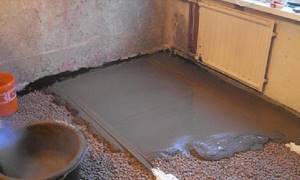
The screed will help level the base under the laminate.
Floor insulation should begin with eliminating surface imperfections. The concrete floor needs to be leveled: fill existing depressions or holes, grind off the bumps, putty on chips and cracks. If the floor is wooden, the boards will have to be removed. You can install waterproofing to prevent moisture from getting into the insulation being installed.
It is advisable to ensure that during the work you have all the necessary tools at hand:
- jigsaw;
- screwdriver;
- drill with various attachments;
- hammer;
- dowels, screws;
- level or rule;
- roulette;
- marker or pencil;
- construction stapler and knife.
Depending on the type of insulation chosen, the list of tools may expand somewhat. For example, to lay expanded clay you will need a shovel, and when using poured materials, you will need a container for their preparation. It is not necessary to purchase the required tools. You can borrow something from friends or rent it - many construction companies now provide such services.
Insulation materials
You can insulate the floor under the laminate:
- expanded clay;
- penofol or mineral wool with foil;
- polystyrene foam;
- coniferous slabs;
- cork or bitumen-cork mats.
For the first option and mineral wool, you will first have to fill the logs, and then lay fiberboard or chipboard on top. Plus, expanded clay bedding can also be made under the screed. All other materials are laid directly under the laminate on top of a concrete or wooden floor.

What types of underlays are there for laminate flooring?
Expanded clay
Among the main advantages of expanded clay are its low cost and ease of use. However, for high-quality thermal insulation, this insulation will have to be poured onto the floor in a layer of at least 10–15 cm. Typically, this option is used when installing a wet concrete screed on the ground. In other cases, it is better to choose something else with a smaller layer thickness.
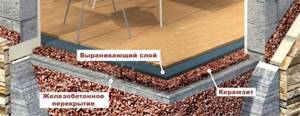
Structure of a floor insulated with expanded clay
Foil and glass wool
Mineral wool is good for its high level of thermal insulation and non-flammability. However, to insulate the floor under the laminate, it will have to be taken with a foil layer in order to minimize the thickness of the underlayment, and laid between pre-installed joists. Plus you will still need to lay plywood or chipboard on top. The cost of laying such a rough covering is quite high, but in terms of service life it is inferior only to expanded clay.
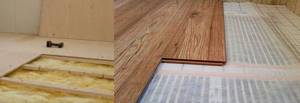
Glass wool and foil also have soundproofing properties.
The foil reflects about 90-95% of thermal radiation back into the room. This is the ideal insulating underlay for laminate floors. And if you don’t want to tinker with mineral wool, then you should take penofol (foiled polyethylene foam). This is almost a complete analogue of the standard soundproofing underlay for laminate, only with the addition of a layer of aluminum foil.
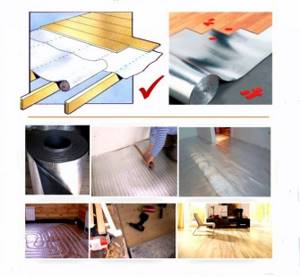
Instructions for laying foil backing
Styrofoam
Foam plastic (EPS) is not afraid of moisture and has excellent strength characteristics, as well as heat and sound insulation. But this is a flammable and not very environmentally friendly material. However, with its help you can easily level a base with many small differences and defects, without resorting to pouring a screed on the existing concrete floor.
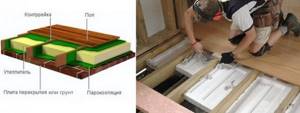
Polystyrene foam is good for insulating balconies and loggias
Coniferous slabs
The boards obtained by pressing pine needles and wood fibers are environmentally friendly, have good sound insulation and a service life of 10–15 years. Their main drawback is the fear of moisture. At the same time, many laminate manufacturers recommend laying a substrate up to 3 mm thick under it. And slabs made of pine needles are usually 4–6 mm or more. Thus, you can lose the warranty on the topcoat due to non-compliance with the manufacturer’s recommendations for the underlying material.
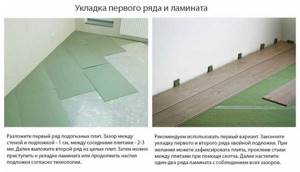
How to lay coniferous boards under laminate
Bitumen-cork underlays for the floor
The technical cork backing stands out among its analogues due to its high price, hypoallergenicity and environmental friendliness. This is a wear-resistant and durable material for floor insulation. But you shouldn’t wet it with water.
After a pipe burst in the house, the cork mats will have to be replaced. Drying them completely and quickly without the formation of fungus inside and/or destruction of the structure is problematic.
A bitumen-cork analogue (parcolag) in the form of kraft paper with a bitumen layer and cork granules is more resistant to moisture. But under heavy loads on the floor, such a mat begins to crumble and collapse.
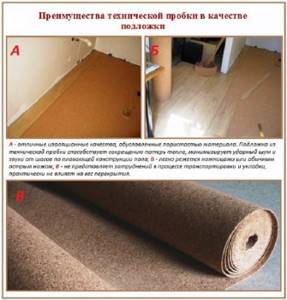
advantages of cork backing
Which manufacturer is better?
Currently, there is a wide variety of manufacturers on the market. Often, a factory that produces insulation produces one lining of one type. Let's discuss the most common ones:
- ISOPLAAT is an Estonian company that produces 5 mm thick coniferous backing, which in turn removes the warranty from most laminated products.
- Teplon is a domestic manufacturer of extruded polystyrene foam lining. The product of this factory can withstand loads of up to 5 tons per m2. The thickness of the sheet is 3 mm, which allows the laminate to be guaranteed.
- ARBITON is a Polish company producing high quality polystyrene foam substrate. This professional material is a foreign analogue of the products of the Teplon factory, and has similar properties.
- IZOLON – is a foamed polyethylene foam covered with a layer of foil. It is considered a fragile material, as it breaks quickly. But the relatively low cost made it widespread.
- Isoshum (ISOSHUM) is a Polish analogue of the IZOLON substrate, with the same performance and technical characteristics.
- TUPLEX is a Finnish factory that produces a combined lining consisting of two layers of polyethylene film and foam granules. There are holes in the bottom layer of insulation, thanks to which condensation does not accumulate under the laminate.
- ICOPAL PARKOLAG – cork-bitumen substrate. The presence of a lot of advantages, elasticity and sound insulation, helped this product take a leading place in the parquet products market.
Laying insulation
The insulation for the laminate is installed using the following technology:
- The base is prepared and leveled with a screed, self-leveling mixture or wood boards.
- As a waterproofing layer, a polyethylene film 200 microns thick is spread on the floor extending 5–10 cm onto the walls.
- The selected insulation is installed.
- Laminate flooring is being laid.
If penofol or polystyrene foam is chosen, then polyethylene will not be needed. In other cases, waterproofing must be installed under the laminate. The only exception is the situation with the installation of such a covering over a wooden floor.
When laying polyethylene strips, it is important to ensure that no gaps form between them. They should be laid with an overlap of 15–20 cm and the joints should be sealed with tape or mounting tape.

Step-by-step instructions for laying cork backing
Recommendations and tips
There should not be any particular difficulties with laying the insulation material. Connecting a dishwasher to water supply and sewerage or installing a thermostat for a gas boiler is even more difficult. In the case of thermal insulation under laminate, the main thing is to do everything consistently and without haste.
In this case, the soundproofing substrate, insulation, polyethylene waterproofing and laminate lamellas should be laid in strips perpendicular to each other in adjacent rows. This will prevent the joints from spreading under future loads.
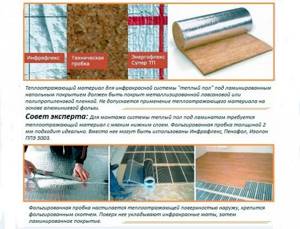
Advantages of foil cork backing
Is it difficult to insulate a concrete floor?
It is recommended to insulate the interfloor ceiling under laminate only if there are rooms below without heating or a damp basement. In other situations, such work is often unnecessary. At the same time, the installation of insulation together with the floor covering can be done independently. There is nothing complicated here.
Watch also the video on how to choose a substrate for laminate:
Read about our other materials:
Glued laminated timber: what is it, photos of houses and reviews from owners
What to do if the gas boiler goes out?
Substrate application
Sometimes, in order to increase the temperature of the floor covering, you can do without using additional insulation.
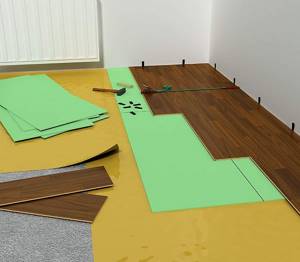
In this case, we are talking about laying a regular substrate. But, in order to carry out high-quality insulation, it is necessary to choose the right substrate.
To make such material, cork, polystyrene and isolon are used. The advantage of the latter option is that it has a relatively long service life.
If you take into account the environmental friendliness of the substrate when choosing, then the best option would be a material made from cork. The thickness of the substrate may vary.
When choosing this option, you should pay attention to the condition of the base and the requirements for thermal insulation. If the base has uneven surfaces, it is better to use a coarser substrate, the thickness of which is 1 cm.
This material is also used in cases where it is necessary to reliably and efficiently insulate the floor. When choosing a substrate, do not forget that it can absorb noise.
